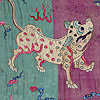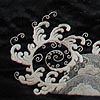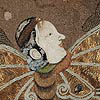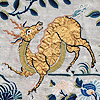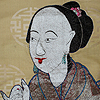 |

2668
Antique Chinese Silk and Gold thread Embroidery panel
1700-1800 A.D
Size 56" x 35"
Size 142 x 89 cm
Top & Below are Detail Images
From Mr.
William Sturgis Bigelow Collection Museum of Fine Arts, Boston Circa 1887
Asian
Textile History

|
Antique Chinese Embroidery

William Sturgis Bigelow (1850–1926) was a doctor and great American collector of Japanese art. He was one of the first Americans to live in Japan[citation needed], and to introduce the American public to Japanese art and culture. He was also among those who worked to establish protections for Japanese art during a time when the Japanese were willing to sell or destroy elements of their own traditional culture in a fervor of Westernization and modernization. Early career A brilliant[citation needed] medical student, Bigelow received his degree in medicine from Harvard University in 1874, and continued his medical studies in Europe for five years, under Louis Pasteur. Though his primary interest was, accordingly, bacteriology, his father was a surgeon, and so he was pressured to perform surgery as well. Bigelow and Japan Instead, in 1882, Bigelow traveled to Japan with Ernest Fenollosa and Edward Sylvester Morse. This may have been intended originally as simply a vacation from the world of medicine, but in the end, Bigelow remained in Japan for seven years. There, he became an art collector, and traveled the country for some time, exploring it and studying its culture, art, and religion. Bigelow would eventually convert to Buddhism. He also contributed financially to the establishment of the Nihon Bijutsu-in (Japan Fine Arts Academy), which was founded by his friend and ofttimes traveling companion Okakura Kakuzo. As a result of the determination of Fenollosa and Morse, as well as their special authorizations under the Japanese government, Bigelow was able to explore parts of Japan closed to outside viewers for centuries. The group visited the Shoso-in (Treasure House) of Todai-ji, viewing hidden treasures of Emperor Shomu, and being granted a few shards of pottery, the only items belonging to the Shoso-in known to currently reside outside of it. Among the many many other items he obtained during his time in Japan were a set of gilt bronze statues from Horyu-ji, of the historical Buddha and attendants, known as the Shaka Trinity statues, and a mandala from the Hokke-do (Lotus Sutra Hall) of Todai-ji, one of the oldest Japanese paintings to ever leave Japan. An experienced photographer, Bigelow recorded many of the sights he and his companions came across. As Fenollosa and Okakura were granted authority by the Japanese government to open temple rooms and storehouses unopened for centuries, in order to record and therefore preserve their contents, Bigelow's photographs of these events are of great historical importance as well. Returning to the United States, Bigelow donated over 40,000 objects of Japanese art to the Museum of Fine Arts, Boston. His efforts, along with those of Morse, Fenollosa, Charles Goddard Weld, Okakura, and a handful of others, made the newly founded Department of the Art of Asia at the Museum of Fine Arts the largest collection of Japanese art anywhere outside of Japan; this is a distinction it still holds today.[citation needed] He was considered "at once an epicure and a mystic, who professed an ascetic religion and wore beautiful Charvet haberdashery."[1] Upon Bigelow's death, in accordance with his final requests, Bigelow's remains were cremated and buried at Mii-dera, just outside Kyoto, along with those of Fenollosa. Bigelow was the man who introduced Baron Kaneko Kentaro to Theodore Roosevelt by a letter of introduction. They first met in 1890 when Roosevelt was Head of the Civil Service Commission and Kaneko was returning to Japan from Europe via the U.S
|
 |

